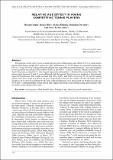Please use this identifier to cite or link to this item:
http://hdl.handle.net/11547/11878| Title: | RELATIVE AGE EFFECT IN YOUNG COMPETITIVE TENNIS PLAYERS |
| Authors: | Söğüt, Mustafa |
| Issue Date: | 2023 |
| Abstract: | The purpose of this study was to examine the presence of the relative age effect (RAE) in young tennis players. Data from a sample of all ranked (n= 3463) and licensed (n= 29150) players in consecutive age groups (10-to 17-year-old) were collected from the official web page of the national federation. They were assigned to four quartiles according to the month of birth: a) Quartile 1 = January-February-March, b) Quartile 2 = April-May-June, c) Quartile 3 = July-August-September, d) Quartile 4 = October-November-December. The players aged between 10 and 17 years affiliated with the national federation were assigned as theoretically expected distribution. The results revealed that 70%, 60.1%, and 56.6% of the top 10, 50, and all ranked players were born in the first half of the year, respectively. However, the results from the chi-square test of goodness-of-fit showed significant RAEs only in the distributions of all ranked and top 50 players at the age of 10 and 11 correspondingly. These results may suggest that RAE exists among young tennis players who are in their early adolescence years. |
| URI: | http://hdl.handle.net/11547/11878 |
| ISSN: | 1331-1441 |
| Appears in Collections: | Web Of Science |
Files in This Item:
| File | Description | Size | Format | |
|---|---|---|---|---|
| 120-127-25625_Sogut.pdf | 810.68 kB | Adobe PDF |  View/Open |
Items in DSpace are protected by copyright, with all rights reserved, unless otherwise indicated.
